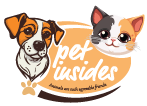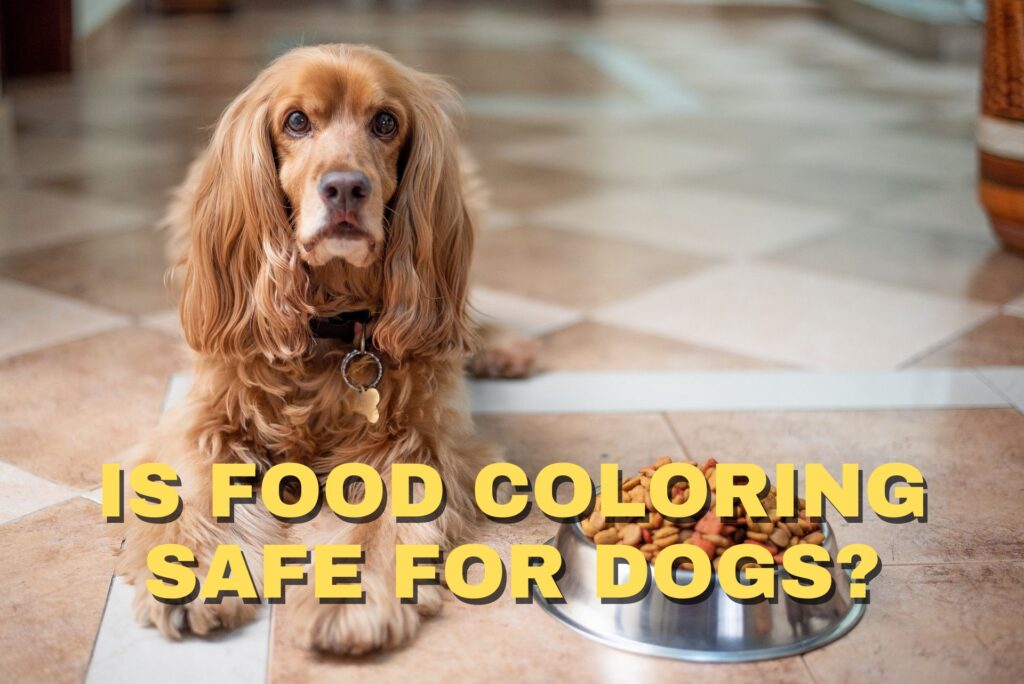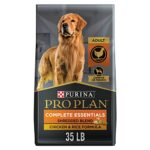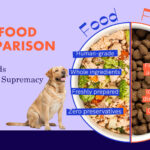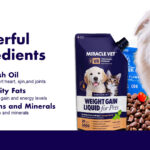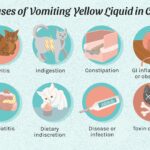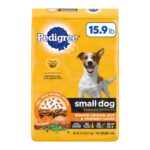Is food coloring safe for dogs in small amounts? but it’s unnecessary for their diet. Always check for specific ingredients that may be harmful.
As pet owners, we always want what’s best for our furry friends, including their diet. While a colorful treat might catch your eye, it’s essential to prioritize your dog’s health over its aesthetic appeal. Though most food colorings used in commercial dog treats are approved by the FDA and are deemed safe for canine consumption, they offer no nutritional value.
Excessive use of artificial dyes can lead to health issues. Therefore, moderation is key. Always ensure you’re aware of your dog’s sensitivities and allergies before introducing colored foods. It’s best to stick to natural, wholesome ingredients to maintain your dog’s health and wellness. Remember, a dog’s diet should be nutritious first and visually appealing second.
Introduction To Food Coloring And Pet Safety
Welcome to our exploration of food coloring and pet safety. Pets are family, and their health is a top priority. This article examines whether food coloring is safe for dogs. Understanding how artificial colors may impact canine health is crucial. Let’s dive into the colorful world of pet food.
Rise In Pet Food Customization
Customizing pet foods has become popular. Owners love giving unique, appetizing meals to their pets. This often includes vibrant colors. These colors mirror human food trends. Yet, safety is key when adding hues to dog diets.
Concern For Canine Health And Additives
Vigilance is necessary with dog food additives. The safety of food colors in pet foods often comes up. Artificial colors are common in treats and kibble. Are these additives safe for our four-legged friends? Pet owners are increasingly cautious. This article addresses these concerns.
Colorful Diets: What Constitutes Food Coloring
A splash of color often makes food more appealing. But what are these hues in our pet’s food? Let’s dive into the world of food coloring. We’ll explore whether it’s safe for our furry friends.
Natural Vs. Artificial Colorants
Dog diets sometimes feature added colors. These colors come in two types: natural and artificial.
- Natural colorants come from plants, animals, or minerals. Think of beet juice or turmeric.
- Artificial colorants are made in labs. They’re designed to mimic natural shades.
Dog owners often prefer natural options. They tend to have fewer health concerns.
Common Food Dyes Found In Pet Foods
Many pet foods have added colors. Look on the label for these common dyes:
| Colorant Name | Type | Source |
|---|---|---|
| Caramel color | Artificial | Processed sugar |
| Red 40 | Artificial | Petroleum by-products |
| Blue 2 | Artificial | Synthetic |
| Annatto extract | Natural | Annatto tree seeds |
Each color adds a unique look. Be aware of artificial dyes like Red 40 and Blue 2, which are commonly used yet sometimes controversial.
Analyzing The FDA’s Stance On Food Coloring
As pet owners, we always want the best for our furry friends. The topic of food coloring in pet treats and food often comes up. But how does the FDA, the authority regulating food safety, view this matter? Let’s delve into the FDA’s perspective on the use of food coloring in dog treats and food and consider the possible implications.
Regulatory Overview
The Food and Drug Administration (FDA) has clear regulations for food dyes. This includes colors added to dog food. The agency evaluates safety, quality, and purpose before approval. These guidelines ensure your dog’s snacks are not just appealing but also safe for consumption.
Permitted Food Dyes For Pet Consumption
The FDA allows specific dyes in pet foods. Below is a list of commonly permitted food colorings:
- Blue 1
- Red 40
- Yellow 5 and 6
- Titanium Dioxide, for whitening
These colorings pass the FDA’s stringent tests for toxicity and safety. Still, it’s vital to note that individual dogs may react differently to them.
| Color | Description | FDA Status |
|---|---|---|
| Blue 1 | A synthetic dye used in various products | Approved for limited use |
| Red 40 | One of the most commonly used food dyes | FDA-sanctioned for pet foods |
| Yellow 5 | Known also as Tartrazine | Passed FDA approval |
| Yellow 6 | A widely utilized coloring agent | Meets FDA standards for pets |
| Titanium Dioxide | A white pigment often found in paints and sunscreen | Approved as a color additive |
Understanding the FDA’s stance helps us select safer treats and foods for our dogs. Despite the FDA’s approval of these dyes, it’s essential to know your pet’s health and dietary needs. When in doubt, consult your veterinarian for the best advice.
Pet Health Implications Of Food Dyes
Pet health implications of food dyes raise concerns among dog owners. Understanding the potential health effects of artificial coloring in pet food is crucial. Can these vibrant additions lead to health issues for our furry friends?
Short-term Effects
Some dogs may show immediate reactions to food dyes. Signs to watch for include:
- Allergic reactions: symptoms like itching and rashes.
- Gastrointestinal upset: Vomiting or diarrhea could occur.
- Behavioral changes: Hyperactivity may be evident in some dogs.
Long-term Risks
Continued exposure to food dyes may pose greater risks.
- Increased cancer risk is linked to certain dyes.
- Potential for organ damage, impacting the liver and kidneys.
- Chronic allergies can develop with long-term exposure.
It’s essential to be mindful of your dog’s diet and the inclusion of artificial colors. Choosing natural or color-free options is often the safer route for pet health.
Allergy And Sensitivity Concerns
Many dog owners wonder about food colorings in their pet’s treats. Dogs can have allergies and sensitivities just like humans. It’s important to know how these dyes might affect them. This part of the article will dive into what symptoms to look for and how to handle sensitivities.
Identifying Allergic Reactions
If a dog eats something with food coloring, they might have an allergic reaction. Signs can show up fast. Here’s a list of symptoms you should watch for:
- Itching or skin rash
- Swelling of the face or paws
- Difficulty breathing
- Gastrointestinal upsets like vomiting or diarrhea
If your dog shows any of these, contact your vet right away. They may be in danger.
Managing Sensitivities
Dogs with sensitivities can live happy lives with the right care. Here’s how you can manage their diet:
- Choose treats without artificial dyes.
- Introduce new foods one at a time. This helps find the cause of any reactions.
- Keep a food diary. Note what they eat and their reactions.
- Talk to a vet about allergy testing or special diets.
Being careful with your dog’s diet can prevent discomfort and keep them healthy.
Behavioral Impact Of Artificial Colors
Many dog owners worry about what they feed their pets. Food coloring in dog treats and food causes concern. But what about its effects on behavior? Artificial colors do more than just make food look appealing. They could influence how dogs act. Let’s dive into the specifics of these potential changes.
Links To Hyperactivity
Hyperactivity stands out as a major concern with artificial color. Dogs showing excess energy might be reacting to these additives. Studies suggest a connection between food dyes and hyperactivity in children. Evidence is building that dogs could be affected similarly. Signs of hyperactivity include the following:
- Excessive barking
- Restlessness
- Constant movement
- Short attention spans
Dogs consuming high amounts of food coloring may show these behaviors. Signs can vary from mild to severe. It’s important for owners to monitor their pets for changes.
Cognitive Effects
Artificial colors could impact a dog’s brain function. This means their ability to learn and remember may be affected. Research in animals suggests a possible link between coloring agents and cognitive function. A dog might demonstrate:
- Difficulty following commands
- Problems with learning new tricks or routines
- General confusion
- Lack of focus during training sessions
A direct cause-and-effect is tricky to prove. Yet these potential cognitive impacts warrant caution. A careful selection of diet is key to a healthy, happy pet.
Toxicology Reports On Food Colors
Is food coloring harming our canine companions? This question echoes in the minds of many pet owners. Recent toxicology reports have shed light on the safety of food colors for dogs. These reports examine the effects of artificial dyes on a dog’s health. Knowledge of food color toxicology is vital for all dog lovers.
Case Studies on Canine Toxicity
Case Studies On Canine Toxicity
Evidence from case studies provides insights into the risks associated with food colors.
- Red 40: Instances of hyperactivity documented in some breeds.
- Yellow 5: Links to allergic reactions in sensitive dogs.
- Blue 2: Cases of increased tumor development observed in studies.
While not all dogs display immediate reactions, case studies signal potential long-term health implications.
Symptoms of Toxic Exposure
Symptoms Of Toxic Exposure
Symptoms of toxic exposure may range from mild to severe. Pet owners must stay vigilant for signs of distress in dogs.
| Symptom | Possible Cause | Action |
|---|---|---|
| Vomiting | Immediate gut reaction to dyes | Consult the veterinarian |
| Itching | Allergic reaction to certain colors | Identify and eliminate the color source |
| Respiratory distress | Severe allergic response | Seek emergency care |
Dog owners should note changes in behavior or physical condition after their pets consume colored foods. Immediate action can prevent long-term health issues.
Examining ‘dog-safe’ Food Colorant Options
Concerns about pet health extend to all areas of care, including treats and special occasion foods. Pet owners often wonder if food colorants added to make treats more appealing are safe for dogs. This post explores options deemed safe for pooches when adding a splash of color to their diet.
Vegetable-based Dyes For Dogs
Vegetable-based dyes stand out as a safe choice for pet treats. Manufacturers derive these dyes from natural sources such as beets, carrots, and spinach. Below is a list of commonly used dog-safe vegetable dyes:
- Beet juice offers a vibrant red hue
- Carrot juice produces an orange color
- Spinach powder gives a green tint
DIY Natural Coloring Alternatives
Creating your own natural food colors can be fun and safe. It also ensures control over ingredients. Here’s how to make some dog-friendly colors:
| Color | Ingredient | How to Use |
|---|---|---|
| Yellow | Turmeric powder | Add a pinch to the mix |
| Pink | Raspberries | Crush and strain for juice |
| Purple | Blueberries | Mash and mix in |
Remember to use these dyes sparingly, as strong flavors might not sit well with your pup. Also, consult a vet before introducing new elements to your dog’s diet.
Industry Trends In Pet Food Coloring
Many pet owners ask, “Is food coloring safe for dogs?” Understanding industry trends in pet food coloring is crucial. Recent years show a shift in how manufacturers color pet food. It affects both safety and marketability. Let’s explore these changes.
Market Shifts Towards Natural Additives
Today’s pet food companies favor natural additives for color. Common additives include:
- Beets for a reddish hue
- Turmeric for yellow tints
- Spirulina for natural greens
Pet food brands have taken note of owners’ preferences. They want their pets to consume foods closer to nature.
| Color | Natural Source |
|---|---|
| Red | Beets |
| Yellow | Turmeric |
| Green | Spirulina |
Consumers prefer recognizable ingredients. They often check labels for artificial colors.
Brands Promoting Color-free Products
Savvy pet food brands are now promoting color-free products. They highlight the lack of artificial dyes. Key points in their marketing include:
- No added artificial colors
- Focus on nutrient-rich ingredients
- Highlighting the natural color of ingredients
These trends show a commitment to pet safety and natural diets. Brands adapt to this shift well.
Nutritional Aspects Of Food Coloring
Many dog owners wonder about the nutritional aspects of food coloring in their pet’s treats. While foods are made colorful, the question remains: Do they offer any nutrients? This section delves into how food colorants affect your dog’s diet and well-being.
Impact On Nutritional Value
Food coloring does not add nutritional value to dog treats. Natural foods give dogs vitamins and minerals. Artificial colors are just for looks. Here’s how they stack up:
- Zero calories: They don’t affect your pet’s energy intake.
- No nutrients: Colors do not supply vitamins or minerals.
- Could mask the quality of ingredients. Always read the labels.
Balancing Aesthetics And Health
Sometimes, treats are colored to look fun. It’s key to balancing looks and health. Here are some tips:
- Choose treats with safe, natural coloring. Think beets or carrots.
- Look for the “pet-safe” label on colored treats.
- Remember: health over appearance. Clear, vibrant colors might not mean the treat is healthy.
Global Perspectives On Canine Food Dyes
When it comes to our furry friends, we all want what’s best for them. But what about the colors added to their treats and kibble? Let’s take a global trot to uncover the safety and regulations surrounding food coloring in dog diets.
International Regulations
Global watchdogs keep a close eye on pet food dyes. Every continent has its own set of rules. Europe’s strict standards and the US’s FDA guidelines suggest safety, but with conditions.
- EU: Only certain dyes are approved with rigorous testing.
- USA: The FDA monitors color additives for toxicity.
- Canada: similar to the USA but with some variations.
- Australia: Pet food standards exist but are voluntary.
- Asia: Varies widely, with Japan having stringent rules.
Even within borders, regions can differ significantly in enforcement and restrictions on pet food additives.
Cultural Attitudes Towards Pet Food Coloring
Views on food dyes are shaped by cultural beliefs and the human-animal bond. Colorful pet foods can appeal to owners more than to pets.
In many cultures, colored kibble is seen as unnecessary. In others, it’s a symbol of pet pampering. Often, the choice reflects the owner’s preference, shaping the demand for such products.
| Region | Attitude |
|---|---|
| North America | There is a high demand for visually appealing pet food. |
| Europe | Preference for natural, additive-free options. |
| Asia | Mixed attitudes, with a growing natural trend. |
| South America | Emerging awareness and demand for natural pet foods. |
Making Informed Choices For Your Pet
Have you ever wondered, “Is food coloring safe for dogs?” As loving pet owners, we want to make sure our furry friends enjoy meals that are not only tasty but also safe and nutritious.
Choosing the right food for your dog requires a blend of care and knowledge. Understanding what goes into their snacks and meals is crucial.
Reading And Understanding Labels
Food labels can seem complex. Yet, they are vital for your dog’s health. Here’s how to decode them:
- Look for the “Guaranteed Analysis.” It shows the percentage of proteins, fats, and fiber.
- Examine the ingredient list. The first items listed are present in the highest amounts.
- Spot food colorings: These are often listed by their chemical names or numbers.
Remember, just because something is edible doesn’t mean it’s safe for your pet.
Consulting With Veterinarians On Diet Choices
Seek advice from experts! Here’s why:
- Personalized Diet Plans: Vets can tailor diets based on your dog’s needs.
- Professional Insights: Receive recommendations on food choices and portion sizes.
- Detecting Allergies: Vets identify ingredients that may not agree with your dog.
Consulting a vet ensures your dog’s diet is both safe and beneficial.
Frequently Asked Questions: Is Food Coloring Safe for Dogs?
Can dogs safely ingest food coloring?
Food coloring is generally considered safe for dogs in small amounts, but individual reactions can vary, so it’s best used sparingly.
What Type of Food Coloring Is Dog-Friendly?
Vegetable-based food colorings are the safest option for dogs due to their natural origin and fewer chemicals.
Does food dye affect a dog’s behavior?
No scientific evidence suggests that food coloring directly affects a dog’s behavior, though individual sensitivities may vary.
Are there any risks to food coloring for dogs?
While not toxic, some artificial food colorings can cause allergic reactions or stomach upset in dogs. Always observe your pet for any adverse effects.
How Do You Identify Safe Food Coloring for Dogs?
Always check for natural or vegetable-based dyes and avoid those with xylitol or other toxic additives for dogs when choosing safe food coloring.
Conclusion
When considering your dog’s diet, it’s essential to prioritize their health. Food coloring may appear harmless, but exercising caution is advisable. Consult with a vet before introducing colored treats to your pet. Natural, dye-free options are the safest path for a healthy, happy pup.
